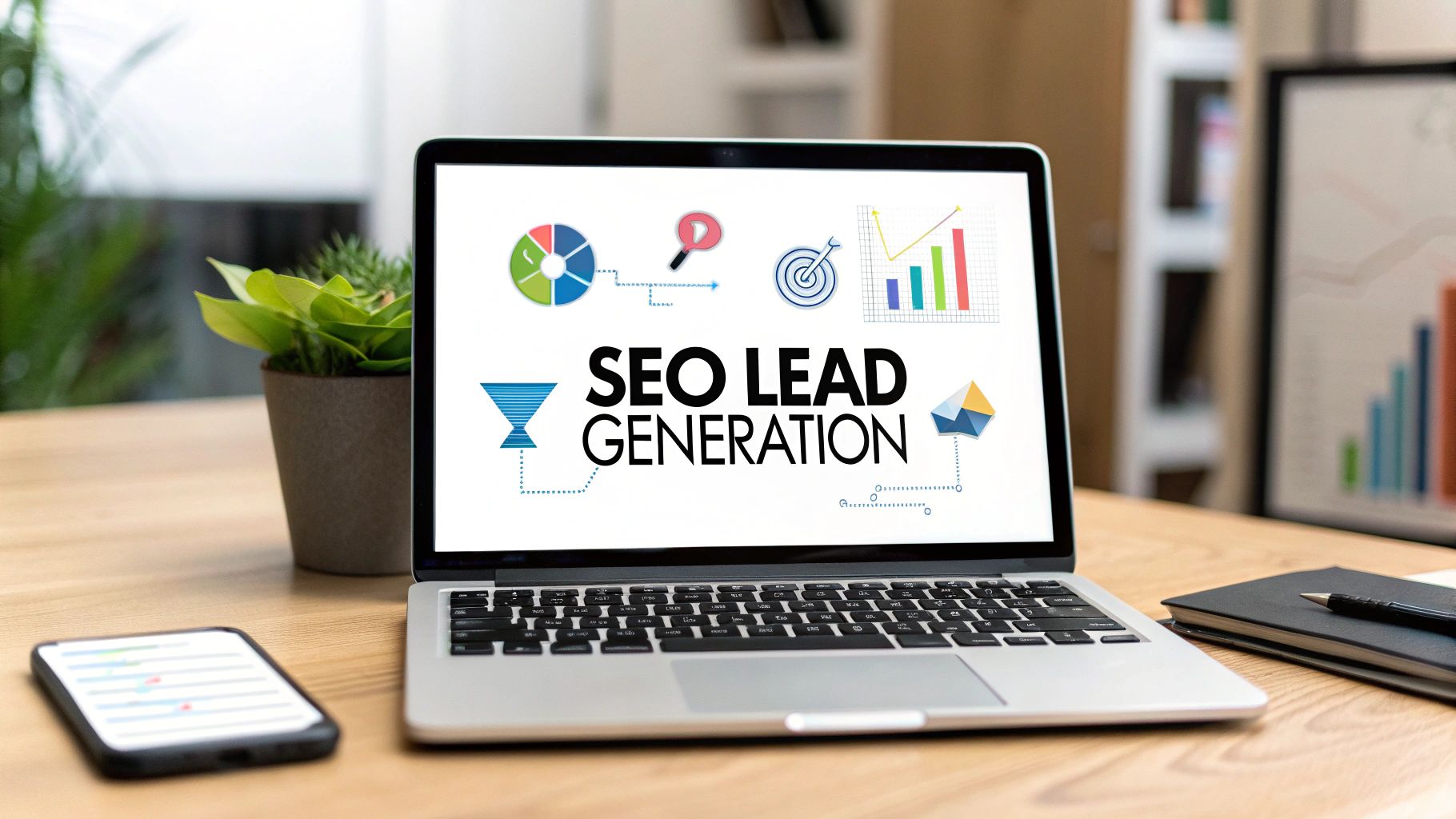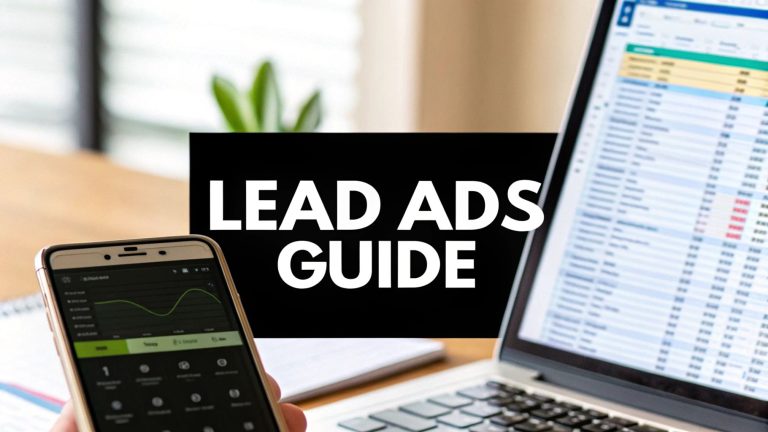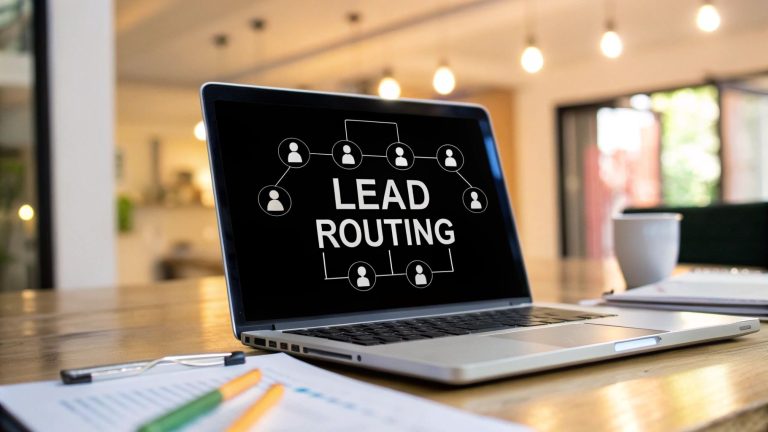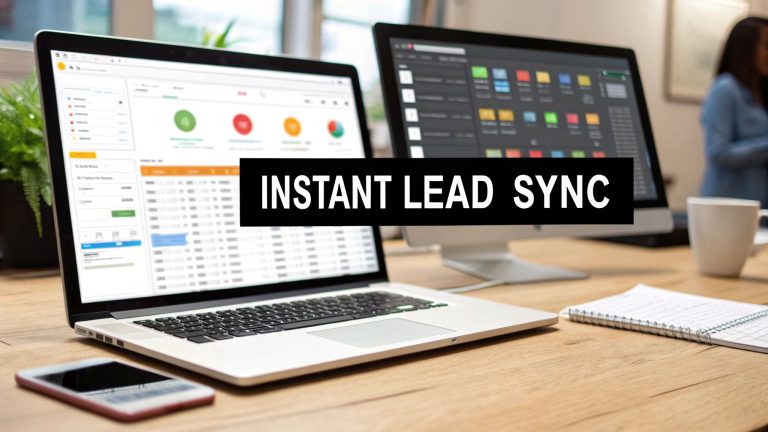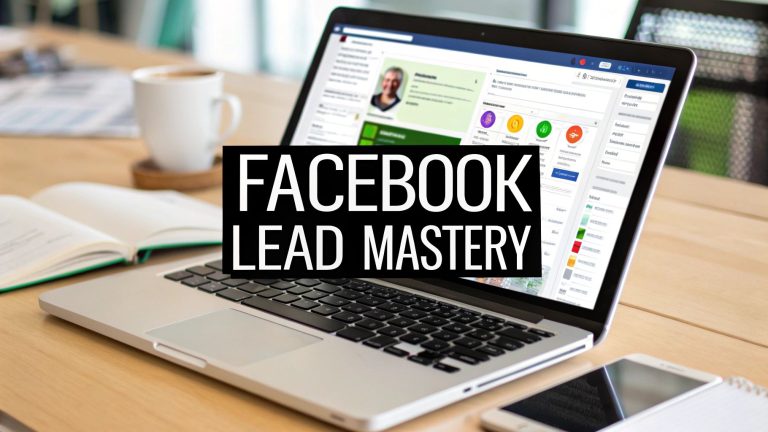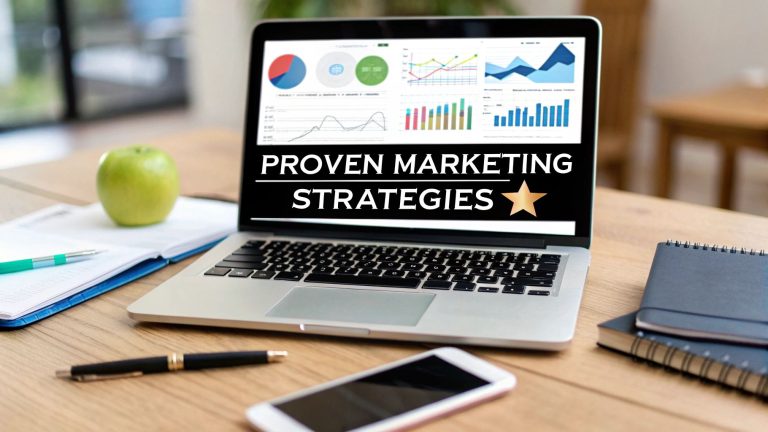Your Guide to SEO Lead Generation
When we talk about SEO lead generation, we're talking about a smart, strategic way to pull in website visitors who are already looking for exactly what you offer. It’s a process of using search engine optimization to attract and convert these highly motivated prospects.
Unlike paid ads, this isn't about a quick, temporary fix. It’s about building a real, sustainable asset that keeps delivering high-intent leads long after you’ve put in the initial work. The whole game is centered on creating value and earning trust to consistently fill your sales pipeline.
Why SEO Is Your Best Lead Generation Engine
It's easy to fall into the trap of pouring all your marketing dollars into paid ads. Sure, platforms like Facebook and Google Ads can give you a quick win, but they operate on a pay-to-play model. The second you stop spending, the leads dry up. It creates a treadmill effect that's both expensive and unpredictable.
SEO is a different beast entirely. You’re not just renting traffic; you're building a digital asset that grows in value over time.
Every piece of content you publish and every backlink you earn adds to your website's authority, creating a powerful compounding effect. Think of it as planting a tree instead of just buying fruit from the store. It takes a bit of time and patience, but eventually, you get a consistent, organic harvest for years to come.
The Power of High-Intent Traffic
The real magic of SEO lead generation is all about user intent. When someone goes to Google, they have a specific problem to solve or a question that needs answering. If your website shows up at the top of the results for their search, you're not an interruption—you're the solution they were actively seeking.
These aren't cold leads you have to warm up. They are inbound prospects who have basically pre-qualified themselves just by searching. This is huge, and it leads to some pretty great outcomes:
- Higher Conversion Rates: Visitors coming from organic search are typically much more engaged and ready to take the next step.
- Increased Brand Authority: When you rank for important industry terms, you're not just getting traffic; you're positioning yourself as a trusted expert.
- Sustainable Growth: A solid SEO strategy creates a predictable flow of leads that doesn’t depend on how much you spent on ads that day.
This infographic really helps visualize how all these pieces fit together to create a growth machine that just keeps running.
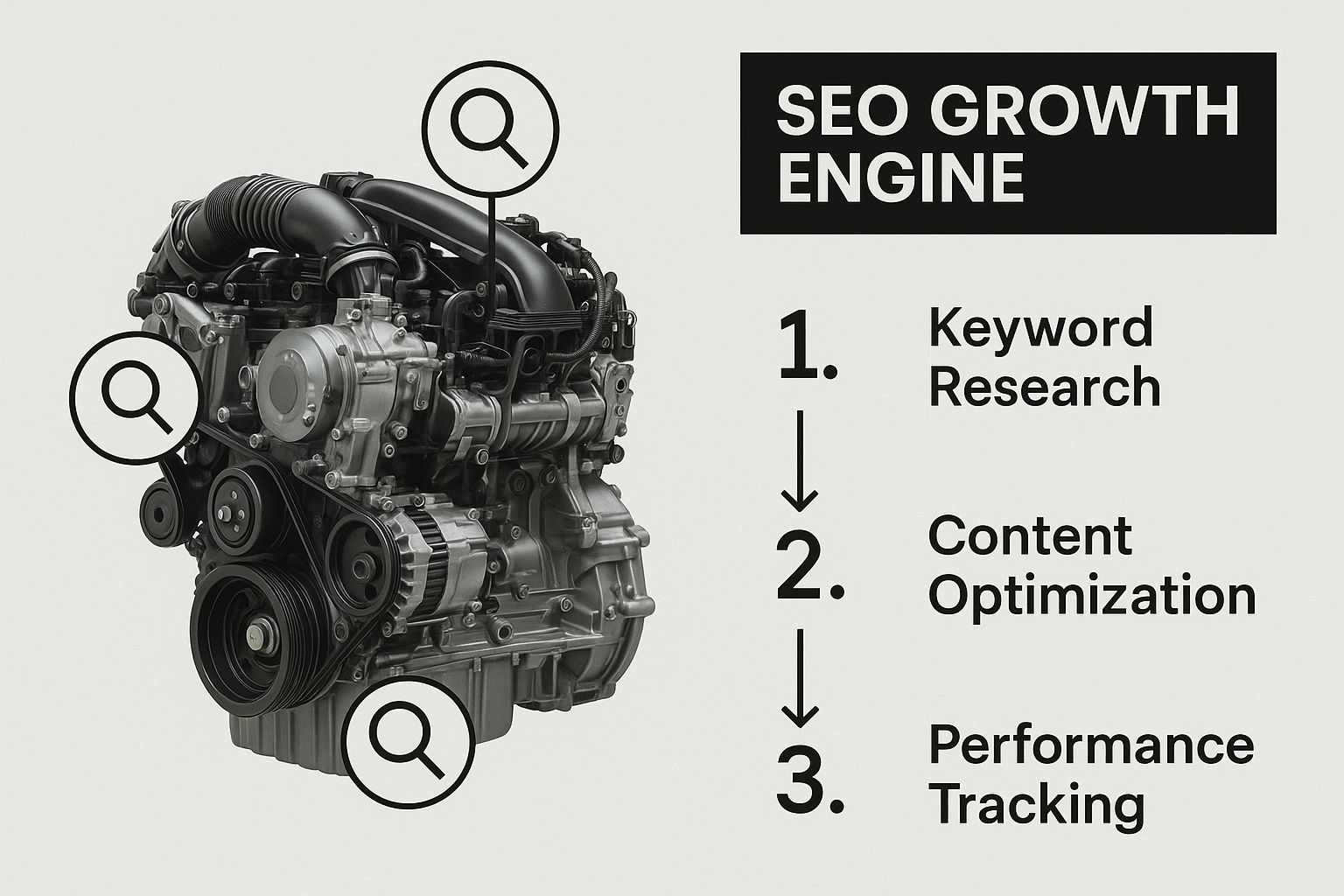
As you can see, SEO isn't just one thing. It's a system where your content, authority, and user experience all work together to generate a steady stream of high-quality leads.
A Cost-Effective, Long-Term Strategy
Building this kind of engine is a proven path to marketing success. The numbers back it up: SEO accounted for 16% of channels that delivered the highest return on investment in 2024.
Even more telling, an incredible 91% of marketers confirmed that SEO was instrumental in helping them hit their main marketing goals. It’s this long-term value that makes mastering organic lead generation a non-negotiable for any business serious about sustainable growth.
Find Keywords That Attract Ready-to-Buy Customers
Let's get one thing straight: SEO lead generation isn't about getting just any traffic. It's about getting the right traffic. You want people landing on your site who are actively looking for the solution you sell, not just browsing for information.
The entire foundation for attracting these ready-to-buy customers is solid Keyword Research. It’s how you figure out what your target audience is actually typing into Google. Nailing this is the difference between a high bounce rate and a pipeline full of qualified leads.
Uncovering User Intent
Every search has a motive. Someone typing "what is project management software" is in a totally different headspace than someone searching for "best project management software for small construction teams." The first person is learning; the second is shopping.
Your job is to zero in on keywords that scream commercial or transactional intent. These are the phrases people use when they have a problem and are ready to pay someone to solve it.
- Informational Intent: These are your "how-to," "what is," or "why" searches. They’re great for building top-of-funnel awareness, but they rarely generate leads today.
- Transactional Intent: These are the money makers. They include words like "buy," "pricing," "for sale," or "service." A search for "emergency plumber near me" is from someone ready to hire. Now.
- Commercial Investigation: This is the sweet spot right before the purchase. Searches like "zapier alternatives" or "quickbooks vs freshbooks" show a user is comparing their options and is a red-hot potential lead.
By focusing your efforts on commercial and transactional keywords, you're putting your content directly in the path of people who are most likely to convert.
Mapping Keywords to the Buyer Journey
To really succeed, you need to capture leads at every stage of their journey. This means mapping your keywords to where a prospect is in their decision-making process, guiding them from "I have a problem" to "take my money."
1. Awareness Stage (Problem-Aware)
Here, a prospect feels the pain but doesn't know what the solution is called. Their searches are broad and informational.
- Example Search: "why are my facebook ad costs so high"
- Your Goal: Be the helpful expert. Offer educational content that defines their problem and introduces your brand as a guide.
2. Consideration Stage (Solution-Aware)
Now they're actively researching different types of solutions. They're comparing products, services, and strategies.
- Example Search: "tools to automate facebook lead management"
- Your Goal: Show them why your type of solution is the best choice. Think comparison guides, in-depth articles, or case studies.
3. Decision Stage (Product-Aware)
They’ve decided on a solution and are now comparing specific brands—including yours. This is where those high-intent, transactional keywords shine.
- Example Search: "LeadSavvy Pro pricing" or "LeadSavvy Pro vs manual download"
- Your Goal: Close the deal. Use targeted landing pages, free trial offers, and demos that prove you're the best choice.
This structured approach makes sure your SEO efforts are working for you across the entire customer lifecycle.
Finding Gaps in Your Competitors' Strategy
One of the smartest shortcuts to finding great keywords is to see what's already working for your competitors. Tools like Ahrefs or SEMrush can show you the exact terms your rivals rank for, basically handing you a proven roadmap.
This snapshot from Ahrefs' Keywords Explorer gives you a quick look at keyword ideas, their search volume, and how hard they'll be to rank for.
You can identify the high-intent keywords they're winning and create something even better to steal the top spot. Even more valuable, you can uncover "keyword gaps"—relevant terms they've completely missed that you can swoop in and own.
Pro Tip: Always look for the long-tail keywords your competitors are ignoring. A phrase like "automate facebook lead ads to google sheets" is super specific, has way less competition, and signals a user with a precise problem you can solve. These niche queries often have the highest conversion rates, hands down.
Create Content That Turns Visitors Into Leads

Ranking for the right keywords is a huge win, but let’s be honest—it’s only half the battle. Traffic doesn't pay the bills. Leads do.
The bridge between a curious visitor and a qualified lead is your content. It needs to do more than just answer a question. It has to solve a real problem and naturally guide the reader toward taking the next step with you.
That’s where effective SEO lead generation comes in. Every piece of content you publish should be a hardworking asset, designed not just to attract eyeballs but to capture contact info by offering undeniable value. This means getting past generic blog posts and creating resources your ideal customer would happily trade an email for.
Design Content for Conversion, Not Just Clicks
The best lead-generating content solves a specific, urgent problem for a very specific audience. Instead of writing broadly, get granular. What’s the exact pain point someone feels right before they need a solution like yours?
For instance, if you're a marketing agency targeting small businesses, you could create:
- An In-Depth Case Study: Show how you helped a similar business double their website traffic. This isn’t just content; it’s proof.
- A Downloadable Checklist: Something like "The 15-Point Local SEO Checklist for Retail Stores" is a practical tool they can use right away.
- A Free Template: A pre-built "Content Calendar Template" in Google Sheets saves your audience time and instantly shows off your expertise.
Each of these examples provides tangible value that goes way beyond simple information. They're practical tools that make your visitor's life easier, building trust and making them much more receptive to your call-to-action.
The goal is to make the exchange a no-brainer. Your content should be so valuable that giving you an email address feels like a small price to pay.
Content marketing is absolutely fundamental here, especially for catching prospects early in their journey. The data backs this up: 75% of content marketers use their work to generate leads. It’s even more critical in B2B, where a massive 85% of marketers rely on content for lead gen, compared to 60% in B2C. This shows how content-driven SEO is brilliant at nurturing potential customers long before they're ready to make a purchase.
Weave in Lead Magnets and Calls to Action
Once you have a high-value piece of content, you need a way to turn that interest into an actual lead. This is where lead magnets and calls-to-action (CTAs) come into play.
A lead magnet is that valuable resource you’re offering (like the checklist or template). The CTA is the prompt that gets them to download it.
Your CTAs need to be clear, compelling, and make sense in the context of the page. Ditch the generic buttons like "Submit" or "Click Here." Instead, use action-oriented language that spells out the benefit.
| Weak CTA | Strong CTA |
|---|---|
| Download Now | Get Your Free SEO Checklist |
| Submit | Send Me The Case Study |
| Learn More | Unlock the Content Calendar Template |
See the difference? The stronger CTAs reinforce the value and create a sense of ownership before the user even clicks. You're being helpful, not salesy. And the form they fill out is just as important. For a deeper dive, check out our guide on creating effective lead capture forms that actually convert.
Structure Your Content for Engagement
How you structure your content is just as important as what you write. Nobody wants to read a giant wall of text, no matter how brilliant your insights are. A visitor will hit the back button in a heartbeat.
Keep these simple rules in mind for everything you publish:
- Use Clear Headings and Subheadings: Break up your content into logical sections with descriptive headings (like the ones in this article). It helps readers find what they need and gives your SEO a boost.
- Write Short Paragraphs: Stick to 1-3 sentences per paragraph. This creates white space, making your content feel less intimidating and way easier to read on a phone.
- Incorporate Visuals: Use images, screenshots, and infographics to illustrate your points. Visuals make complex ideas easier to grasp and help break up the text.
- Leverage Lists and Bullet Points: For steps, benefits, or key takeaways, use bullet points. They’re highly scannable and help readers digest important info quickly.
When you combine valuable, problem-solving content with smart, reader-friendly formatting, every article you publish becomes a powerful engine for SEO lead generation.
Tune Your Website for Maximum Lead Conversion

Getting a steady stream of qualified traffic to your website is a huge win. But let's be honest, traffic doesn't pay the bills. Leads do.
The real test of your SEO lead generation strategy isn't just getting clicks—it's turning those clicks into actual, paying customers. This is where you roll up your sleeves and start fine-tuning your site, transforming it from a simple brochure into a lead-generating machine.
Crafting Click-Worthy SERP Snippets
Your first impression happens before anyone even lands on your page. It happens right there in the Google search results. A magnetic title tag and meta description can make all the difference, convincing high-intent searchers to choose you over the competition.
Think of your title tag as the headline for your webpage's ad. It’s that blue link in the search results and needs to be concise, packed with the right keywords, and promise a clear solution to whatever the user is searching for.
Your meta description is your 160-character sales pitch. While it won't directly boost your rankings, a persuasive one practically begs to be clicked. Focus on benefits, include a subtle call to action, and make sure it perfectly matches the content on the page.
Optimizing Landing Pages for Action
Okay, they clicked. Now what? Your landing page has seconds to deliver on the promise you made in the search results. Every single element—from the headline to the button color—should guide the visitor toward one specific goal.
Once you’ve got visitors on your site, applying proven 10 Conversion Rate Optimization Best Practices is the key to turning them into leads. This isn't a one-and-done task; it's a constant cycle of testing, learning, and improving.
Here’s a quick-reference table to help you nail the on-page essentials.
On-Page SEO Checklist for Lead Generation
This checklist covers the must-have elements for turning your landing pages into conversion powerhouses.
| On-Page Element | Optimization Goal | Practical Example |
|---|---|---|
| Headline | Instantly confirm the page's value and match the searcher's intent. | "Instant SMS Follow-Up for Facebook Leads" instead of "Our Services". |
| Copy | Highlight benefits over features using scannable, persuasive language. | Use bullet points to list outcomes, not just technical specs. |
| Forms | Make it ridiculously easy to submit information. Remove all friction. | Ask for only Name, Email, and Phone. Not their entire life story. |
| CTAs | Use clear, action-oriented text that tells users exactly what to do. | "Get My Free Demo" is much stronger than a generic "Submit". |
| Social Proof | Build immediate trust by showing that others have found success. | "Trusted by 500+ Agencies" or a short, powerful customer testimonial. |
By checking these boxes, you're creating a clear and compelling path for your visitors to follow.
A Key Insight: Never underestimate the power of social proof. Adding testimonials, client logos, or case study snippets can crush visitor uncertainty. It shows them that real people have already gotten value from what you're offering, making their decision to convert that much easier.
Technical SEO That Fuels Conversions
All the persuasive copy in the world won't matter if your website is slow, clunky, or broken on mobile. The technical health of your site is the invisible engine driving your conversion rates. A bad user experience is a guaranteed way to lose leads.
Site speed is everything. We've all been there—clicking a link and then immediately hitting the back button because the page took too long to load. Studies have shown that even a one-second delay can slash conversions by 7%. Compress your images, clean up your code, and make speed a top priority.
And it absolutely has to work on a phone. With more than half of all web traffic coming from mobile devices, a clunky mobile experience is unacceptable. Your buttons need to be easy to tap, your text readable without pinching and zooming, and your forms simple to fill out on a small screen. If it's frustrating to use on a phone, you’re just sending leads directly to your competitors.
Measure and Scale Your Lead Generation Wins
You can't grow what you don't measure. Sure, driving traffic and getting sign-ups is a great start, but the real secret to successful SEO lead generation is digging into the data to understand your wins—and then using those insights to do more of what works. This is how you stop guessing and start building a predictable pipeline.
First things first, you need to set up conversion goals in a tool like Google Analytics. You have to explicitly tell the platform what a "lead" actually means for your business. Is it someone filling out a form? Signing up for a free trial? Downloading a PDF? Without tracking these specific actions, you have no way to connect your SEO work to actual business results.
Establishing Your Core Conversion Goals
Flying blind is a recipe for wasted effort. You might see traffic climbing, but you'll have no idea if those visitors are turning into actual prospects. Your goals have to be specific, measurable, and tied directly to your sales funnel.
Here are a few must-have goals to set up right away:
- Contact Form Submissions: This is the classic. Track every single time someone hits "submit" on your "contact us" or "get a quote" form.
- Lead Magnet Downloads: If you're offering a guide, checklist, or template, each download is a top-of-funnel conversion you need to track.
- Demo or Consultation Requests: For any SaaS or service business, this is a high-intent goal. It signals someone is ready to talk turkey.
This Google Analytics dashboard is a perfect example of how you can visualize these conversions over time. It helps you spot trends and see the real impact of your campaigns at a glance.
When you can see your goal completions charted out like this, you can quickly tell what's working and which pieces of content or traffic sources are driving the most valuable actions.
Identifying the KPIs That Actually Matter
Once you have tracking in place, you can zero in on the key performance indicators (KPIs) that tell the true story. Forget vanity metrics like raw traffic or keyword rankings—they don't pay the bills. The numbers below are what really define your success.
Your main focus should be the cost and quality of the leads you're generating. A huge one is your organic Cost Per Lead (CPL). While you aren't paying for clicks, you can calculate this by dividing your total SEO investment (content, tools, salaries) by the number of organic leads you generated.
Another vital KPI is your lead-to-customer conversion rate. This tells you what percentage of your SEO leads actually become paying customers, giving you a crystal-clear picture of lead quality. You can dive deeper into which metrics to watch in our complete guide to lead generation KPIs.
By tracking both CPL and lead quality, you can finally prove the ROI of your SEO work. If your organic leads close at a higher rate and cost less than your paid leads, you’ve built a powerful case for doubling down on your strategy.
Scaling Your Success with Data-Driven Insights
With solid data, you can finally make smart decisions to scale what's already working. Look at your analytics and start asking the tough questions. Which blog posts generate the most downloads? Which keywords are driving the most consultation requests? The answers are your roadmap for what to do next.
The economics of SEO lead generation become incredibly clear when you look at CPL across different industries. As of 2024, the average CPL hovers around $198, but that number swings wildly. B2B tech companies, for example, often see CPLs north of $200—a cost that's easily justified by the high lifetime value of a single client. You can find more industry breakdowns and learn more about lead generation statistics to benchmark your performance.
Use these insights to refine and scale your efforts:
- Double Down on High-Performing Content: Find the topics and formats that bring in the most leads and create more content just like it.
- Optimize Underperforming Pages: Got pages with good traffic but no conversions? Figure out why. Maybe you need a better CTA, a relevant lead magnet, or just tighter copy.
- Refine Your Keyword Strategy: Shift your focus to the commercial-intent keywords that are proven to drive high-quality leads, even if their search volume is a bit lower.
This constant loop of measuring, analyzing, and refining is exactly how you build a predictable, scalable SEO lead generation engine that fuels real, long-term business growth.
Got Questions About SEO Lead Generation? Let’s Clear Things Up.
Jumping into any new marketing strategy feels a bit like stepping into the unknown, and SEO lead generation is no exception. It’s an incredibly powerful way to grow your business, but it definitely comes with a learning curve.
Let's tackle some of the most common questions and roadblocks I see businesses run into when they first start using organic search to fill their sales pipeline. Getting straight answers helps you set the right expectations and build a strategy that actually works.
How Long Does SEO Actually Take to Generate Leads?
This is the big one, isn't it? The honest, no-fluff answer is: it depends. But you can generally expect to see the first trickle of organic leads within 3 to 6 months of consistent, focused effort. That initial period is all about getting on Google's radar as you publish new, optimized content.
For SEO to become a serious, predictable engine for your business, you’re usually looking at a timeline closer to 6 to 12 months. Think of it like building a reputation in the real world—it doesn't happen overnight. As your website's authority grows from great content and solid backlinks, the results really start to snowball, bringing in better leads, more often.
Patience is the name of the game here. Unlike paid ads that give you an instant (but temporary) boost, SEO is about building a long-term asset. The leads are almost always higher quality, and your ROI just keeps getting better over time.
What’s the Difference Between SEO for Traffic and SEO for Leads?
They might sound the same, but the strategies are worlds apart. SEO for traffic is purely a numbers game—it's about getting as many eyeballs on your site as possible. That usually means targeting broad, informational keywords to maximize visitors, whether they're ready to buy or not.
SEO for leads, on the other hand, is much more surgical.
- It’s all about intent: We're prioritizing keywords with commercial or transactional intent. These are the phrases people type in when they’re actively researching a solution or are damn close to making a purchase.
- The conversion is the goal: Getting the click is just the first step. The real focus is on what happens after they land on your site. This means obsessing over landing page experience, crafting killer calls-to-action (CTAs), and making your forms dead simple to fill out.
- Quality beats quantity, every time: A page that pulls in 100 highly qualified visitors and turns five of them into leads is infinitely more valuable than a page that gets 5,000 casual readers and zero leads.
Basically, SEO for traffic casts a wide net. SEO for lead generation uses a perfectly crafted lure to catch the exact fish you want.
Can I Really Generate Leads with SEO on a Small Budget?
Absolutely. A tight budget doesn’t knock you out of the game; it just means you have to be smarter and more focused. Instead of trying to go head-to-head with the big players for super competitive keywords, you just need to carve out your own niche.
Your best move? Zero in on niche, long-tail keywords. These are longer, more specific search phrases that have lower search volume but often convert like crazy. For example, instead of chasing "marketing automation," you might target something like "automate Facebook lead forms to Google Sheets." The person searching for that has a very specific pain point you can solve right now.
You should also pour your energy into creating genuinely helpful, in-depth content that answers your audience's questions better than anyone else. And if you’re a local business, local SEO is your best friend. It might take a bit longer without a big budget for link building, but a consistent, focused strategy can still bring in a steady stream of high-quality leads.
How Important Are Backlinks for Lead Generation, Really?
Super important. Backlinks are still one of the most powerful signals in SEO. Think of them as a vote of confidence from other websites. When a reputable site links to your page, it tells search engines that you’re a trustworthy, authoritative source on that topic.
That authority is what helps your most important, lead-generating pages climb the rankings for those high-value keywords. Without a decent backlink profile, it's incredibly tough to rank for the terms that bring in the most valuable, ready-to-buy traffic.
You can definitely get started and generate some leads without a massive backlink portfolio—especially by targeting those less competitive long-tail keywords. But earning high-quality links is what will truly accelerate your results. It’s what separates a good strategy from a great one and lets you compete for the most profitable searches in your industry.
Stop wasting time on manual downloads and start converting leads faster. LeadSavvy Pro automates the entire process, sending your Facebook leads directly to your CRM or Google Sheets the moment they come in. Get started for free today and see the difference.

